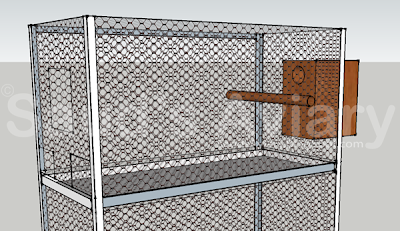2.2 Visual & Split
First I will briefly summarize the last post. Two copies of most genes are found in the cell. These two copies may be the same or different. If the two copies are different one gene may dominate the other such that it completely hides the effect of the other. The gene that dominates and shows its effect on the bird is called dominant. The gene that has no visual effect even though a copy of it is present is called recessive.
Let’s consider the Green and Blue budgie example again. The color genes in the green bird are denoted by GG and the blue genes by BB. When these birds are paired we represent the color genetics as follows
GG X BB
= 100% GB
This means that 100% or all the offspring will inherit one copy of the color gene from each parent (G from one and B from the other) resulting in the GB genes. We already know that green is dominant to blue so all chicks will be green. You may ask at this point, how is it that we know that green is dominant to blue? We learn about the nature of genes from test breeding. The experience of breeders before us tells us the nature of common genes. You can find a list of common mutations and their inheritance properties for each species easily on the web. eg: http://www.euronet.nl/users/hnl/symbols.htm (We will learn about the other modes of inheritance mentioned in this table later on). It is important to note that the blue gene is recessive across many parrot species including budgerigars, lovebirds, Indian ringnecks, alexandrines and many more. The result for a green to blue pairing are therefore the same in all these species.
Visual & Split
The above pairing produced chicks with one green and one blue gene GB. This bird is colored like its green parent. In other words it is not possible to tell by looking at the color of the bird if it has two copies of the green gene GG or one Green gene and one Blue gene GB. In genetic terms the hidden gene is referred to as a split. We say that the bird is green split to blue. A bird with two copies of the blue gene BB is blue in color. It is called a visual blue.
Let’s make things a little more interesting and see what happens if we pair this green bird split to blue GB to a visual blue bird BB. To understand this let us imagine that each bird has a deck of playing cards. All cards in the hand of the blue bird show a B. The green split blue bird has mixed cards half of which say G and the other half say B. They play a simple game. Each bird throws a random card the two cards that come together, one from each bird, become the genes of the offspring. The blue bird always throws a B since that is all it has got. The Green split Blue can throw a G or a B. In 50% of the cases we will end up with BB and the other 50% we will have GB. We already know that BB is visual blue and GB is green split to blue. We write this genetically as follows
Visual Blue - BB X Green Split Blue - GB
50% GB - Green split to blue
50% BB - Visual Blue
I will leave you with some homework. Try the following pairings
1) Green Split Blue X Green
2) Green Split Blue X Green Split Blue
We will learn a formal method of predicting pairing outcomes in the next episode.


1) 50% visual green split to blue
ReplyDelete50% green
2) 25% visual green split to blue
25% green
25% visual blue split to green
25% blue
2) 25% green
Delete50% visual split to blue
25% visual blue
Salaam Dr. Saud.
ReplyDeleteYour cousin Dr. Muzammil introduced you to me and my cousin Arif Zaidi also met you in Karachi. I have tried to download AviMan but after download it is not working. I will keep in touch with you and learn a lot from you. May I have your cell no, please. Mine is 0300 789 2929. I am a Urologist in Multan.